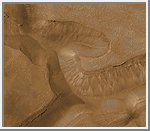|
COMETS EARTH JUPITER KUIPER BELT MARS MERCURY METEORITES NEPTUNE OORT CLOUD PLUTO SATURN SOLAR SYSTEM SPACE SUN URANUS VENUS ORDER PRINTS
PHOTO CATEGORIES SCIENCEVIEWS AMERICAN INDIAN AMPHIBIANS BIRDS BUGS FINE ART FOSSILS THE ISLANDS HISTORICAL PHOTOS MAMMALS OTHER PARKS PLANTS RELIGIOUS REPTILES SCIENCEVIEWS PRINTS
|
Related Documents
Download Options
The first two pictures (top and above left) are from the Mars Global Surveyor (MGS) Mars Orbiter Camera (MOC) and show a series of troughs and layered mesas in the Gorgonum Chaos region of the martian southern hemisphere. The picture at the top of the page is a portion of the picture on the left above. The Viking view (above right) shows the location of the MOC image in the chaotic terrain. Gullies proposed to have been formed by seeping ground water emanate from a specific layer near the tops of trough walls, particularly on south-facing slopes (south is toward the bottom of each picture). The presence of so many gullies associated with the same layer in each mesa suggests that this layer is particularly effective in storing and conducting water. Such a layer is called an aquifer, and this one appears to be present less than a few hundred meters (few hundred yards) beneath the surface in this region. The MOC pictures were taken on January 22, 2000. The sample at the top of the page is an area 3 kilometers (1.9 miles) wide by 2.6 km (1.6 mi) high. The long view (above left) covers an area 3 kilometers (1.9 miles) wide by 22.6 km (14 mi) long. Sunlight illuminates each scene from the upper left. The images are located near 37.5°S, 170.5°W. The context image (above right) was acquired by the Viking 1 orbiter in 1977 and is illuminated from the upper right, north is up. MOC high resolution images are taken black-and-white (grayscale); the color seen here has been synthesized from the colors of Mars observed by the MOC wide angle cameras and by the Viking Orbiters in the late 1970s. |
